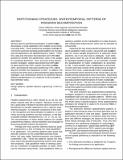Partitioning strategies: Spatiotemporal patterns of program decomposition
Author(s)
Hoffmann, Henry Christian; Agarwal, Anant; Devadas, Srinivas
DownloadDevadas_Partitioning strategies spatiotemporal.pdf (144.4Kb)
OPEN_ACCESS_POLICY
Open Access Policy
Creative Commons Attribution-Noncommercial-Share Alike
Terms of use
Metadata
Show full item recordAbstract
We describe four partitioning strategies, or patterns, used to decompose a serial application into multiple concurrently executing parts. These partitioning strategies augment the commonly used task and data parallel patterns by recognizing that applications are spatiotemporal in nature. There fore, data and instruction decomposition are further distinguished by whether the partitioning is done in the spatial or in temporal dimension. Thus, we arrive at four decomposition strategies: spatial data partitioning (SDP), temporal data partitioning (TDP), spatial instruction partitioning (SIP), and temporal instruction partitioning (TIP), and catalog the benefits and drawbacks of each. In addition, the practical use of this work is demonstrated by applying these strategies, and combinations thereof, to implement several different parallelizations of a multicore H.264 encoder for high-definition video.
Description
Link to the conference: http://www.iasted.org/conferences/pastinfo-668.html
Date issued
2009-11Department
Massachusetts Institute of Technology. Computer Science and Artificial Intelligence Laboratory; Massachusetts Institute of Technology. Department of Electrical Engineering and Computer ScienceJournal
21st IASTED International Conference on Parallel and Distributed Computing and Systems, PDCS 2009
Publisher
International Association of Science and Technology for Development
Citation
Hoffmann, Henry, Anant Agarwal and Srinivas Devadas. "Partitioning Strategies: Spatiotemporal Patterns of Program Decomposition." Proceedings of the 21st IASTED International Conference on Parallel and Distributed Computing and Systems, PDCS 2009. 668-021.
Version: Author's final manuscript
ISBN
978-0-88986-838-0
978-0-88986-811-3